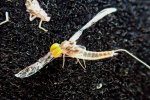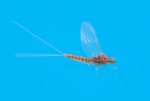Looks like it is some sort of insect though. Try some fly paper if you want to catch one. You might also go get your self some permethrin and do a spray around your yard, that should take care of the problem for you.
Please identify this stuff appearing in > 20ppm FC
- Thread starter arri
- Start date
You are using an out of date browser. It may not display this or other websites correctly.
You should upgrade or use an alternative browser.
You should upgrade or use an alternative browser.
Side note ... Thanks for the weird question instead of the same usual things that we answer 


I had already tried answering my own "usual" question with the TFP method. I was sure it wasn't pollen, but I hadn't looked so closely at it to determine it might not be algae until I attempted to actually compose a forum post. Nevertheless, I wanted to make sure I had exhausted my SLAM options before I came crying to the forum for help only to find out that like so many others I had not actually kept my FC up, or hadn't accurately measured CYA before starting or any of the other common issues.
Anyway, I can't thank all of you enough. If I do identify the eggs I'll report back.
Anyway, I can't thank all of you enough. If I do identify the eggs I'll report back.
- May 23, 2015
- 24,480
- Pool Size
- 16000
- Surface
- Plaster
- Chlorine
- Salt Water Generator
- SWG Type
- Pentair Intellichlor IC-60
Re: Please identify this stuff appearing in > 20ppm FC
Late to the party but as soon as I saw the first photo I was with Dave - eggs. Eggs would not be harmed by chlorine as the sack would keep the chlorine out. Higher organisms like insects are rarely affected by chlorine at pool water concentrations. Borates will kill many types of bugs and that will stop egg laying. But, in general, a chlorinated swimming pool is just a nice big happy clean pond for bugs to play in.....
Late to the party but as soon as I saw the first photo I was with Dave - eggs. Eggs would not be harmed by chlorine as the sack would keep the chlorine out. Higher organisms like insects are rarely affected by chlorine at pool water concentrations. Borates will kill many types of bugs and that will stop egg laying. But, in general, a chlorinated swimming pool is just a nice big happy clean pond for bugs to play in.....
Hardly late to the party, I just posted this morning! Every opinion counts and gives me strength in letting my FC go back to normal again.
We're going to keep to a morning regimen of brushing the eggs off and probably run the Dolphin more than normal. I'm having trouble deciding whether to reinstall the light and just clean it every day or leave it out a few more days for easy access.
I'm also tempted to leave one of the spots and see if it grows in size since that would suggest they aren't eggs. However, from what I've seen they seem to release with any water movement before 24 hours pass.
We're going to keep to a morning regimen of brushing the eggs off and probably run the Dolphin more than normal. I'm having trouble deciding whether to reinstall the light and just clean it every day or leave it out a few more days for easy access.
I'm also tempted to leave one of the spots and see if it grows in size since that would suggest they aren't eggs. However, from what I've seen they seem to release with any water movement before 24 hours pass.
I think they might be mosquito eggs.
They seem to be arranged in a pattern similar to what you see. Assume they come in a variety of sizes and colors depending on species.
https://youtu.be/bXjmPLYjdTY
Jeff
They seem to be arranged in a pattern similar to what you see. Assume they come in a variety of sizes and colors depending on species.
https://youtu.be/bXjmPLYjdTY
Jeff
I think they might be mosquito eggs.
They seem to be arranged in a pattern similar to what you see. Assume they come in a variety of sizes and colors depending on species.
https://youtu.be/bXjmPLYjdTY
Jeff
Fascinating!! [emoji50]
I pulled this specimen off the surface this morning. I can't tell if the yellow things are the eggs or not, but it seems to me they're at the wrong end of the animal for birthing. It's possible this animal is not the generator of eggs but actually a consumer of them.
FYI, there were two tail pieces but I broke one off while handling it. Kind of looks like a mayfly to me.

FYI, there were two tail pieces but I broke one off while handling it. Kind of looks like a mayfly to me.

- May 23, 2015
- 24,480
- Pool Size
- 16000
- Surface
- Plaster
- Chlorine
- Salt Water Generator
- SWG Type
- Pentair Intellichlor IC-60
That looks a lot like a mayfly (same family as dragon flies). Some species lay eggs in and under water in clusters.
You can look it up on Wikipedia.
You can look it up on Wikipedia.
Here's another much better photo of the same type of bug which I am seeing on the water. Again, it's unclear that these are actually connected to the eggs in any way aside from the prior photo where something similar to the eggs were near the mouth.
View attachment 86625

Mayfly - [emoji476]
Saturn94
Bronze Supporter
- Mar 11, 2015
- 1,752
- Pool Size
- 20000
- Surface
- Vinyl
- Chlorine
- Salt Water Generator
- SWG Type
- Hayward Aqua Rite (T-15)
Check out the pic in this link.
The Classic Fly Rod Forum The Bug Thread
It says they are likely mayfly eggs.
The Classic Fly Rod Forum The Bug Thread
It says they are likely mayfly eggs.
That’s great link Saturn.
I am fortunate to live 5 minutes from the Farmington River.
I am fortunate to live 5 minutes from the Farmington River.
I agree that the insects I photographed are mayflies and that the photo in that fly fishing thread looks similar. However, in reading the wikipedia article and speaking with an entomologist it still seems unlikely the eggs I photographed belong to a mayfly despite similar appearances and dimensions. The biggest reason being their being located on the walls to a depth of three feet commonly and on occasion even deeper. They were also found inside the light niche consistently at a depth of three feet. These locations point more toward an insect who lives in the water rather than one who just lays their eggs in the water and occasionally gets them below the surface.
As the water temperature is now dropping into the mid seventies the quantity of daily patches has decreased substantially.
From the mayfly page on the wikipedia:
Females typically lay between four hundred and three thousand eggs. The eggs are often dropped onto the surface of the water; sometimes the female deposits them by dipping the tip of her abdomen into the water during flight, releasing a small batch of eggs each time, or deposits them in bulk while standing next to the water. In a few species, the female submerges and places the eggs among plants or in crevices underwater, but in general, they sink to the bottom. The incubation time is variable, depending at least in part on temperature, and may be anything from a few days to nearly a year. Eggs can go into a quiet dormant phase or diapause.[13] The larval growth rate is also temperature-dependent, as is the number of moults. At anywhere between ten and fifty, these post-embryonic moults are more numerous in mayflies than in most other insect orders. The nymphal stage of mayflies may last from several months to several years, depending on species and environmental conditions.[5]
As the water temperature is now dropping into the mid seventies the quantity of daily patches has decreased substantially.
From the mayfly page on the wikipedia:
Females typically lay between four hundred and three thousand eggs. The eggs are often dropped onto the surface of the water; sometimes the female deposits them by dipping the tip of her abdomen into the water during flight, releasing a small batch of eggs each time, or deposits them in bulk while standing next to the water. In a few species, the female submerges and places the eggs among plants or in crevices underwater, but in general, they sink to the bottom. The incubation time is variable, depending at least in part on temperature, and may be anything from a few days to nearly a year. Eggs can go into a quiet dormant phase or diapause.[13] The larval growth rate is also temperature-dependent, as is the number of moults. At anywhere between ten and fifty, these post-embryonic moults are more numerous in mayflies than in most other insect orders. The nymphal stage of mayflies may last from several months to several years, depending on species and environmental conditions.[5]
Thanks for the interesting read! You learn something every day  Best of luck with your egg clutches!
Best of luck with your egg clutches!
Thread Status
Hello , This thread has been inactive for over 60 days. New postings here are unlikely to be seen or responded to by other members. For better visibility, consider Starting A New Thread.


